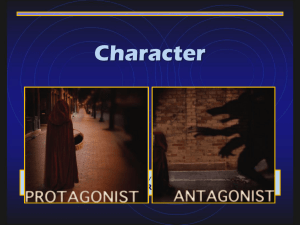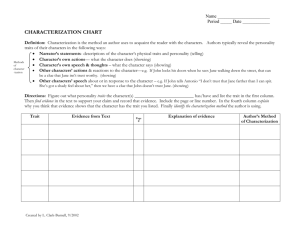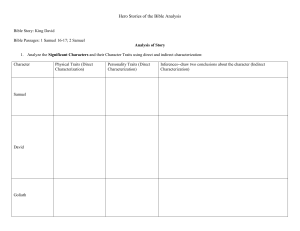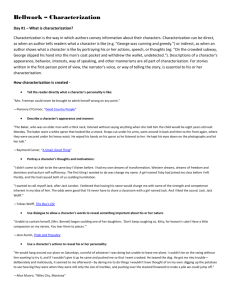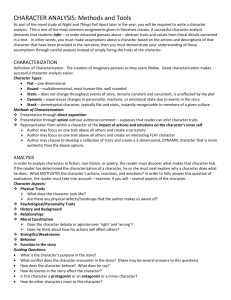thank you m'am - Public Schools of Robeson County
advertisement
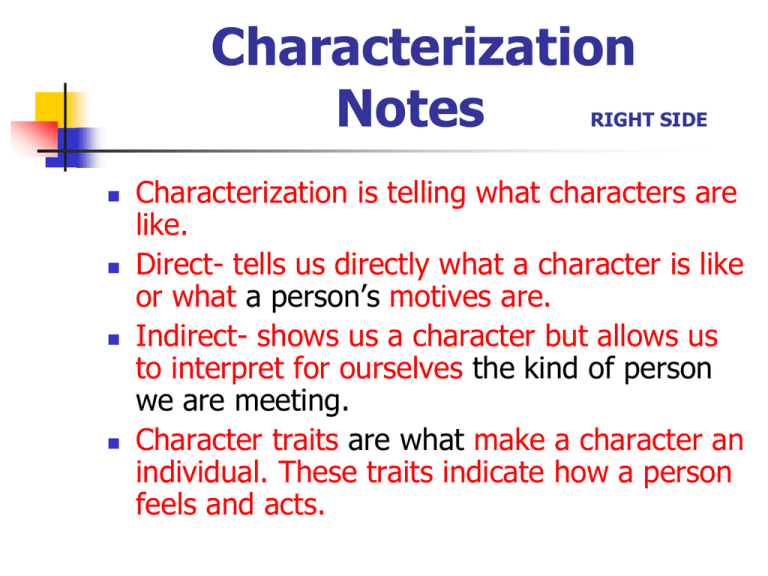
Characterization Notes RIGHT SIDE Characterization is telling what characters are like. Direct- tells us directly what a character is like or what a person’s motives are. Indirect- shows us a character but allows us to interpret for ourselves the kind of person we are meeting. Character traits are what make a character an individual. These traits indicate how a person feels and acts. Categorizing Direct and Indirect Characterization Paired Activity With your partner, decide if A and B in paragraph pair 1 is an example of direct characterization or indirect characterization? Do the same with paragraph pair 2. CHUNK and CLUNK (10 min) Categorizing Direct and Indirect Characterization Directions: Divide class in half Each team will have a set of characterization examples Chunk the examples in one of the two piles (direct characterization) or (indirect characterization) Think-Pair-Share LEFT SIDE Write a sentence describing a girl named Patty to define each type of characterization. Direct Indirect Methods of Characterization STEAL Authors reveal the traits of their characters through action, dialogue, and direct statements. Speech (a character’s own words) Thoughts (What a character thinks) Effects on Others (how other characters in the story feel and interact with a character) Actions (what a character does) Looks (how a character looks) Identify the Methods of Characterization Class Activity 1. 2. 3. 4. 5. “She is wearing tennis shoes and a shapeless grey sweater over a summery calico dress.” “Get out of my way!” screamed Debbie “I was here first!” “Enter: two relatives. Very angry. Potent with eyes that scold, tongues that scald.” “Every few yards, we abandon the struggle, sit down, and pant.” “Maybe I’m just not very bright,” Clovis thought. “I didn’t pass that basket-weaving class . . . again.” Types of Characters Round- has many traits like a real person Flat- has very few traits Static- stays the same Dynamic- develops and changes Subordinate/Secondary- minor characters who don’t play a main part to the story’s plot Exit Slip List the five methods of characterization. (STEAL) Stick it on the Wall Remember This? Define each character type: dynamic static flat round Character Motivations Motivation is what drives a character’s actions. It explains behavior and reveals personality. Writers rarely make direct statements about a character’s motivation. Instead, they plant clues and rely on readers to make inferences from those clues. Making Inferences An inference is an educated guess- a guess based on good evidence. To make an inference: >Look for details in the text >Relate the details to what you know about life >Make a careful guess Making Inferences An inference is a logical statement based on facts. It is not a wild guess. Making Inferences Suppose your sister said, “Guess what we’re having for breakfast?” Suppose, also, that you Could not see anything Could not smell anything cooking Could not hear anything cooking Had not been told what was for breakfast Making Inferences Any answer you gave would be a wild guess because you had no knowledge of the facts. If, on the other hand, you had Smelled bacon Seen the orange juice Heard the toaster pop up Making Inferences Then you would have many facts on which to base your answer. Thus, it would not be a wild guess if you said, “We are having _______, _______, and _______ for breakfast. Quite the opposite! Your answer would be based soundly on known facts. Using Facts to Make Inferences Use the five W’s to make inferences. Who When Where What Why Making Inferences by Using the 5W’s Clues (15 min) Complete the Exercise E Making Inferences Sheet Let’s Discuss it What Does Your Speech say about you? RIGHT SIDE We use language to express our identity. Every time you speak, you give listeners information about who you are and where you come from. Dialect (also called colloquialism) is a way of speaking that is characteristic of a particular region or group of people. What Does Your Speech say about you? Dialect can determine: your social class your education Standard English: Is easier to understand Is the spoken language in schools/universities Accepted by institutions Recognized by the government Colloquial Expressions and Dialect Class Activity: Match the colloquial English with standard English. ain’t not/aren’t coz / ‘cos dunno ‘em Gimme gonna gotta lemme lotta wanna whatcha ya .... a haven’t /hasn’t got/am .... .... .... .... .... .... .... .... .... .... .... b going to c I don’t know d let me e you, your f want to g have got to h them i what are/do you j lot of k because l give me Brain Break-Litter Box Rules/Directions: Partners ball up a piece of paper and place it on the desk. Partners pick up the paper and place the paper ball in the trash bin. Using elbow and elbow only!! Characterization Literary Terms Pg. 1019 (10 min) Study for Test !! Direct characterization Indirect characterization Protagonist Antagonist Subordinate character Motivations Dialect Inference Round character Flat character Dynamic character Static character Dialogue First-person narration (point of view) Sequence Illustrating Character Traits Group Word Knowledge Project (You will be given a rubric) (35 min) Directions: Students will receive a list of five words and will create illustrated character trait sheets for each of the words. Students will take one of four roles… Researcher looks up the definitions of character traits. Remember, it’s important to choose the right definition. Recorder writes on the project paper. You are responsible for the word, the definition, and the description of the action. Director thinks of actions that show the character traits. Also, help the researcher put the definitions in your own words. Illustrator draws pictures that show the character traits. Other group members may help color your pictures. Example of Character Trait Illustration The character trait Gregarious The definition One who is friendly, sociable, or likes company. A drawing showing how the character trait could be implied or indirectly linked to a character A ________ character might… A gregarious character might Description of how the character trait shake hands with new people could be shown. they meet. Exit Slip List three of the five words your group learned with a synonym to match to show the meaning of those words. Stick your post-it-note on the wall. Character Traits Worksheet Individual Activity (15 min) When your group finishes the project complete the in-class section of the character traits worksheet. In class: Define the character trait. Include a synonym for the word. Homework: Write what a character showing that trait might do. Brain Break: Stand & complete these rebus puzzles Knee on Lights = Neon Lights Four in Language = Foreign Language Tuesday Middle of the Night Back Seat Driver Review Character Traits Which character trait from your character traits worksheet would match each synonym? Jealous Full of Desire Thoughtful Mean & Hateful Nice & Respectful Good at your job Answerable Firm Gullible Acting strangely-Up to something Exit Slip Choose three character traits you have learned today, and on your index card write a complete sentence with each. Around the Room Literary Terms (20 min) With your partner you will move around the room to complete each workstation. **If you do this correctly, you will end where you started. Complete chart for each workstation. Folder Color (definition) Blue Definition Write each definition and then find your answer. Copy only what is highlighted. This is the beginning of the story where characters, setting, and conflicts are introduced. (exposition) Green When you finish, begin the literary terms crossword puzzle. Complete both tasks to earn one quiz grade!! Folder Color (answer) Green Integrity: What does it mean? Having sound moral principles. Having the courage to do what is right, even if it is difficult. Being honest, fair, and trustworthy. Class Activity: Create a list of people who show or should show integrity and a list of people who often do not show integrity. Integrity No Integrity Class Discussion: Is it more natural to have integrity, or more natural not to have integrity? What might cause people to have integrity or to lose their integrity? Class Discussion: Can people improve the integrity of others through their own actions? Why or why not? If yes, how? If no, why not? Interactive Notebook Quickwrite: Think and write about the integrity you show through your actions, including actions at school. (7 min) LEFT SIDE How do those actions affect others? What can you do to improve your own integrity and integrity of those around you? Include the following in your writing: • Write about a time when your integrity was challenged or compromised and what you did or what you could have done differently. • How has your integrity (or lack of integrity) affected the integrity of other people? T: “Thank You, M’am” A: Langston Hughes G: short story Pages 86-90 MEET THE AUTHOR LANGSTON HUGHES He was born in Joplin, Missouri on February 1st , 1902 City of Joplin, Missouri Motto: "Proud of Our Past...Shaping Our Future'“ His great-great-grandfather was the first Black American to be elected to public office. He really wanted to live with his parents, but he could not. The Negro Speaks of Rivers was one of his most famous poems appearing in Brownie's Book. He received a scholarship to Lincoln University, in Pennsylvania, where he received his B.A. degree in 1929. Langston Hughes died of cancer on May 22, 1967. BEING REALISTIC What would you do if someone came up from behind you and tried to steal your purse/wallet? How would you react? Would you react positively or negatively? What would motivate a person to steal? End of paragraph 1 Class Discussion Make connections: What would you do if you were the boy? If you were the woman? Make judgments: Was it okay for the woman to kick and shake the boy until his teeth rattled? Justify her actions. Class Activity: Sequence the first part of the story according to the events. when a boy ran up behind her and then she reached down, picked up the boy by his shirt front and shook him the boys weight and the weight of the purse combined caused him to lose his balance she was a large woman with a large purse walking tried to snatch her bag but until his teeth rattled Paragraphs 3, 4 and 5 Class Discussion Make a judgment: Is the boy a hardened criminal? Do you think he has done this before? Give evidence. Make connections: What would you do in a situation like this when you are being questioned by an adult? Should an adult ask the question the woman did and expect an honest answer? Class Discussion How old is Roger? Which method of characterization is the author using to show this? Make a judgment: Is the boy being honest with his apology? If so, why do you think he is being honest? Class Discussion What did Mrs. Jones mean when she said, “You ought to be my son. I would teach you right from wrong.” Do you think all children who do wrong has not been taught right from wrong? Or are they just deciding to do wrong? Infer: What is it that Mrs. Jones is telling the boy in the key speech about coming in contact with her? Predict: What will she do to make the boy remember her? Class Discussion What can you infer about Mrs. Bates marital life, family life, and financial status from where she lives? Class Discussion What evidence on page 89 does Mrs. Jones give us to show that Roger is hungry? End of paragraph 30-36 Class Discussion What were Roger’s motivations for trying to steal Mrs. Jones’s purse? What does she mean by “neither tell God, if he didn’t already know.” End of paragraph 37 Class Discussion Infer: What has changed so that Mrs. Jones does not protect her purse or try to keep Roger in her apartment? Make a judgment: Why does Roger want to be trusted? End of story Class Discussion Express in your own words what Mrs. Jones means by “shoes got by devilish ways will burn your feet.” Make judgments: Would it have been a better story if she had stayed in his life? Evaluate This! (Left Side) Which is the dynamic character and which is the static character in this story. Give details to explain your answer. Mrs. Jones Roger A letter from Roger Homework: LEFT SIDE What do you think Roger will be like ten years after his encounter with Mrs. Jones? Compose a letter from Roger using the first person narrative structure. Include Roger’s present address in the letter. Be sure to state the purpose of his communication after all these years. Writing a Letter What are the parts of a letter? What is the very first thing you put on a letter? Clue : It goes in the upper right corner. Date What do you call the line that starts “Dear ____,”? Greeting What are the parts of a letter? What do you call the main part of your letter? Body What do you call the line that starts “Sincerely”? Closing What do you call the line that contains your name? Signature Where does the date go? July 1 4, 2002 1 2 2 3 3 4 5 Where does the greeting go? July14, 2002 Dear 2 2 Mom, 3 3 4 5 Where does the body go? July14, 2002 Dear 2 Mom, Thank you for taking me shopping yesterday. I had a 3 new school great time finding clothes. I can’t wait for school to start so everyone can see my new clothes. 3 4 5 Where does the closing go? 1 4, 2002 July Dear Mom, 2 Thank you for taking me shopping yesterday. I had a great time finding new school clothes. I can’t wait for school to start so everyone can see my new clothes. 3 Love, 4 5 Where does the signature go? 1 4, 2002 July Dear Mom, 2 Thank you for taking me shopping yesterday. I had a great time finding new school clothes. I can’t wait for school to start so everyone can see my new clothes. Love, 5Fred Love, This is what your letter will look like. July14, 2002 2 Dear Mom, Thank you for taking me shopping yesterday. I had a great time finding new school clothes. I can’t wait for school to start so everyone can see my new clothes. 3Love, Fred 3-2-1 Exit Ticket Fill out your ticket on the index card provided. 3 Things I learned today about writing a letter… 2 Things I found interesting about the story we read… 1 Question I still have about characterization… Interactive Notebook Activity Complete the chart: list the traits in the correct columns in the chart below, and find details in the story to support your answers. (15 min) LEFT SIDE Character Traits Self-assured Kindhearted tough troubled lonely timid generous strong young scared Mrs. Jones Roger Story Details Story Details Honors: Reflective Writing Task Choose and copy one prompt then respond. (It must be one page in length) Does poverty cause people to lose their integrity? Support your answer with examples and evidence. Are some people born with more integrity than others? Support your answer with examples and evidence. Some say that there is “honor among thieves.” Can people who do not obey the laws of the land and who do criminal acts still have integrity by being loyal to fellow law-breakers? Is this integrity? Why or why not? Support your answer with examples and evidence. School work often challenges our integrity. When is it dishonest or unfair to help a friend with school work? Is it ever the right thing to do? If you have not always had integrity, it may have caused someone to distrust you. Perhaps this is a friend, a teacher or a parent. Did you re-establish trust with this individual? How long did it take to re-establish trust? Use specific examples or evidence. Study for Test!! Study all literary terms and notes.

